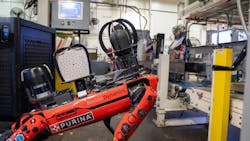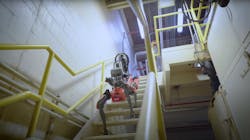Predictive maintenance technicians have better things to do than walk up and down countless stairwells across a plant to point acoustic sensors and thermal cameras at equipment for hours at a time. If only a robot excelled at climbing up and down stairs…
Oh. Wait. Boston Dynamics has a bunch of those. They’re called Spot. And who better to assist in the manufacture of dog food (among other pet care products) than a robot dog? [Editor’s Note: Sit, Spot. Fetch, Spot. Monitor a few million dollars’ worth of specialized manufacturing equipment to track acoustic abnormalities and heat buildup, Spot. Good boy! – Robert Schoenberger]
Adopting a Fresh Technology
Roger Brecht, vice president of digital manufacturing, in 2021 took the leash of Nestlé Purina’s digital transformation program for its North American pet care plants and presented options for the company’s next project, including an automated cleaning solution akin to industrialized Roombas and industrial exoskeletons, but the pitch for a quadruped robot won, hands-down.
Nestlé Purina’s nascent predictive maintenance system used IoT devices to gather data on critical OT assets. The company did not consider expanding IoT coverage to non-critical assets financially responsible, and technicians didn’t always have time to make the rounds and gather inspection data to feed the predictive algorithm.
Spot, on the other hand, could support acoustic and thermal gear payloads and make routine inspection runs on a regular basis. When paired with the static, IoT-based solution, Spot could provide Nestlé Purina with the needed data to expand its predictive maintenance program plant-wide. In June 2022, the company decided to conduct a proof of concept test (POC).
“The first question that always got asked was from a people safety perspective. What is in place to protect our employees? That’s our No. 1 priority, so we needed to alleviate those concerns. And then my colleague, who leads our quality team, wanted to understand what food safety risks that bringing something like this into the environment presents that we need to be aware of? Once those two things were answered, then it just boils down to what’s the estimated return on investment?” says Brecht.
Finding Forever Homes
Nestlé Purina’s plant in Clinton, Iowa, where Brecht previously served as a factory manager and that often serves as a testbed for new digital solutions and technology deployments, hosted Spot’s POC. The official pilot took place in a high performing plant that used automated guided vehicles (AGVs) whose technicians were comfortable working around an autonomous robot.
Based on feedback from these initial deployments, Brecht put together a change management routine [Obedience training regimen? – ed.] for Spot installations at the company’s North American plants.
“The person that’s been leading the rollout from our team… does a preliminary site visit, and she will take one of the robots and really allow anybody and everybody at the site to come and ask questions and understand the technology and understand what it’s being used for. We try to generate excitement and be very clear that our approach to automation like this is absolutely not about job or employee replacement. Rather, it’s going to allow you to focus on more value-added and more rewarding activities instead of some of the repeatable, manual, mundane task work that we’ve been doing the past 35 or 40 years. … I think her approach is…a large reason why we’ve had success at the implementation so far,” Brecht says.
Traditional automation options like large, caged robots have obvious limitations. Smaller robot arms and cobots can accomplish more dexterous tasks but even when mounted on casters aren’t terribly mobile.
Spot, on the other hand, [Who only needs a doggie bed recharge cradle – ed.] can literally climb stairs and represents one of the most adaptable automation solutions ever introduced to manufacturing plants. The list of potential applications to replace human effort runs considerably longer than for Spot’s ancient, caged ancestors or cobot cousins.
Quadruped robots therefore could generate unique anxieties among plant operators and technicians compared to previous automation solutions. Brecht says that Nestlé Purina cultivates a keen awareness of those potential concerns.
“Whether it’s something like Spot, or ‘How is generative AI going to potentially impact my job as a manufacturer?’ Those are legitimate questions that go through people’s minds as we advance, because technology is advancing so much faster year over year than it has historically.… Being clear on what your digital transformation journey is all about and how does automation play into it, what’s your strategy, why are you using automation…clearly articulating that in advance is important. That’s how you can get out in front of what otherwise will be assumptions that start to churn,” says Brecht.
Rather than dealing with technicians’ fears, Brecht has the opposite problem of trying to handle suggestions for potential, future use cases for Spot that pour in from across all Nestlé Purina’s North American plants [Because who doesn’t like a new puppy for Christmas? – ed.], 15 of which already have Spot units running. Brecht says the other seven plants will have the robot installed by the end of Q1 next year.
“[Spot] is absolutely a pull because there are far more benefits than just what it’s delivering. For ROI, helping a site with our predictive maintenance strategies for those sites that have it deployed. It’s a huge recruiting tool and has been extremely helpful…with not only attraction, but retention. It’s actually opened up a new role at our factory sites [robot wrangler] that didn’t exist before…so there’s a different career path as a result of this. Just a ton of interest. We honestly can’t implement [the robots] fast enough,” says Brecht.
Quickly Earning its Treats
Brecht based his ROI for the Spot deployments on energy savings and overall equipment efficiency (OEE) improvement, reducing equipment stops or failures based on improving Nestlé Purina’s predictive maintenance program.
“We didn’t even factor in any sort of labor savings, allowing the robot to do the work versus the technician doing the walking work. It’s all been predicated on hard savings from cost avoidance with non-failures,” Brecht says.
While he won’t throw hard numbers on an assessment, Brecht does say that he anticipated Spot to meet ROI projections in two years. For most of the deployments thus far, it takes only one year to hit ROI.
“Every plant has different maturity levels in workforce, in technical teams, in maturity of their predictive programs, etc. So, there’s going to be some plus and minus there. But as we net out, we’re fairly consistent that we’re seeing the same type of delivery, which is what has us excited. You try to be somewhat conservative in a pilot POC because the last thing you want to do is over promise and under deliver and it gets tricky. And this technology looks really fun and cool. So you’re battling this perception that you’re playing with toys. [Like tennis balls or sticks. – ed.] So we wanted to be a bit conservative, but we’re ecstatic about what it’s delivering,” Brecht adds.
While Nestlé Purina currently uses Spot only to look for thermal abnormalities and acoustic leak detection, Brecht hopes that at some point they’ll introduce vibration analysis. Nestlé Purina has also partnered with the University of Michigan’s robotics program to help develop new use cases. One of the most advanced projects involves equipping Spot with a cobot-like armature.
“It’s the craziest thing you’ve ever seen, and then you get to the point where you’re almost callous to it. You’re in a factory, and you’re seeing this dog stop and start routes, and you don’t even think anything of it anymore. So that just shows you how quickly things evolve.”
[Editor’s Note: Sorry, Robert couldn’t help himself. – Dennis Scimeca]
About the Author
Dennis Scimeca
Dennis Scimeca is a veteran technology journalist with particular experience in vision system technology, machine learning/artificial intelligence, and augmented/mixed/virtual reality (XR), with bylines in consumer, developer, and B2B outlets.
At IndustryWeek, he covers the competitive advantages gained by manufacturers that deploy proven technologies. If you would like to share your story with IndustryWeek, please contact Dennis at [email protected].



